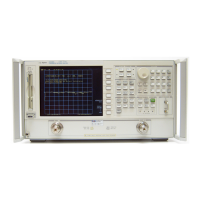Service Guide 7-15
8719ET/20ET/22ET Source Troubleshooting
8719ES/20ES/22ES Broadband Phase Lock Problems
RF Network Analyzers
• If the voltage waveform and the counter values are bad, continue with “Substituting
Tuning Voltages to Check the VCO” on page 7-16.
• If the instrument passes both checks, the probability is greater than 90% that A13
and A14 are functional: go to “Pulse Generator (A52) Check with Oscilloscope” on
page 7-19, “Pulse Generator (A52) Check with Spectrum Analyzer” on page 7-20, or
“Check the VCO (A14) Range with Oscilloscope” on page 7-16 to confirm.
Check the Fractional-N Analog (A13) and Fractional-N Digital (A14)
with a Spectrum Analyzer
1. Press the following:
2. Set the parameters on the spectrum analyzer:
• start frequency = 50 MHz
• stop frequency = 250 MHz
• bandwidth = 300 kHz
3. Remove the instrument bottom cover and disconnect the A52J1 cable from the A52
Pulse Generator.
4. Connect the spectrum analyzer to the output of A14 via the A52J1 cable.
5. Slowly turn the network analyzer front panel knob to tune the signal across the entire
frequency range.
You should see a signal that is about 0 dBm at 120 MHz and below. You should see the
signal drop approximately 2.5 dB above 120 MHz.
6. Look for sidebands on the signal.
The signal should appear very clean without any sidebands present, however, you will
observe source harmonics.
• If any sidebands do appear on the signal, there could be a faulty A13 fractional-N
analog assembly.
• If you see pieces of the signal dropping out (possibly in steps) when you are tuning
the signal across the frequency range, there could be a faulty A14 fractional-N
digital assembly.
• If a clean signal appears across the entire frequency range, you can assume that the
A13 (fractional-N analog) and the A14 (fractional-N digital) assemblies are working
correctly.
Preset
Preset
System

